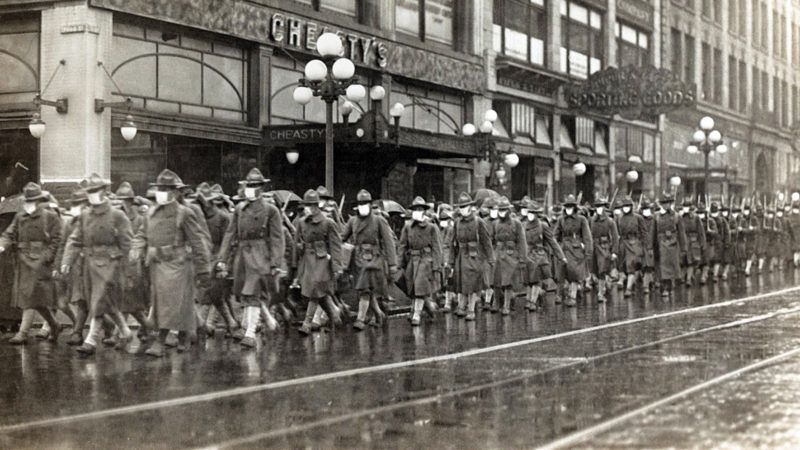What Is the Macroeconomic Analog to Coronavirus Panic?

All leaders, not just generals, tend to fight the last “war.” All readers of Hayek know why: they feel compelled to promulgate a response but lack sufficient information to make optimal decisions. They all have a vague sense that historical precedent might prove a useful guide, so they ask, “what worked last time?” and implement it. Hence a massive fiscal stimulus to combat COVID-19 because TARP et al worked (allegedly) in 2008-9.
What leaders ought to ask is, “what worked the last time we faced a similar shock?” and go from there. The global pandemic that occurred a century ago (1918-19) is an obvious starting place but the world was at the end of the largest war in history (to that point) when that contagion struck. In fact, the war deepened its spread and the contagion killed a much higher percentage of young people, especially young men, than COVID-19 has.
With many of its doctors “Over There,” the American healthcare system was swamped in some places, like Philadelphia, leading to excess mortality. With domestic manufacturing geared toward the war effort, corpses outnumbered coffins in the City of Brotherly Love 10-to-1. (America’s war dead were put into canvas bags and buried in Europe, at least temporarily, so coffins were not counted essential war material.)
The second and third waves of the Great Pandemic struck as demobilization began, conflating the effects of returning troops with shuttered businesses. In short, we should definitely study the Great Pandemic’s economic effects closely, but it remains messy for modeling.
A cleaner model, I think, comes from the invasion and occupation of parts of France for extended periods in World War I. (In World War II, part of France remained nominally free of Nazi rule but de facto under the boot heel of the Third Reich). I hate it when politicians label everything a war, but President Trump has indeed invoked the Defense Production Act. And I don’t know if the crisis is the moral equivalent of war, but it seems to be the economic equivalent of invasion and occupation. Consider this:
The peacetime French (US) economy was doing well in the years prior to 1914 (2020) before being invaded by vicious Huns (SARS-CoV-2) who effectively shut off the portion of the French economy that they controlled (areas hit by COVID-19). While the unoccupied (un-shuttered) parts of the French (US) economy experienced an increase in aggregate demand due to the dire need for war material (PPE, etc.), the French (US) economy simultaneously experienced a negative supply shock due to the occupation (government-imposed economic restrictions).
Positive demand shocks lead to classic wartime economies in which real output and the price level increase. Negative supply shocks, however, lead to reduced real output and an increase in the price level.
So the standard Aggregate Demand and Supply model predicts prices will definitely go up and in wartime France they did, by 500 percent, twice the increase in prices in its uninvaded ally, Great Britain. So look for the Fed to meet or exceed its 2 percent inflation target in the coming quarters if the war on COVID-19 long continues. An early sign will be consumers complaining of the spread of “price gouging.”
The effect on real (inflation-adjusted) output depends on the relative size of the demand and supply shocks. The Germans seized about two-fifths of French heavy industry during the Great War, so it is not surprising to learn that French GDP shrank by a quarter during the war. French males even grew shorter on average over the course of the conflict due to nutrition shortages.
What will happen in the US case remains unclear but basically the nation’s two most productive areas, greater New York City and Silicon Valley, have been occupied. Some production and trade are still occurring and being shared with the rest of the country but a lot of their output, including many services, are no longer part of US GDP. Elsewhere, enemy troops are disrupting supply lines and such but have yet to consolidate control, while other areas suffer simply from fear of invasion.
Yes, that is vague. Fine-grain data collection efforts by others are underway. Hopefully, though, they will not be needed.
The solution for France and America is the same, to retake the lost territory and production from the invaders. To do so, France suffered an estimated 6.2 million casualties during the war, or almost three out of every four men mobilized, and the British Empire lost another 3.2 million dead or wounded, most young men in the prime of life.
With help from the U.S.A., the Allies eventually won back France’s territory (including that lost in a previous war) but their Russian allies suffered a far grimmer fate in the form of defeat, revolution, and seven decades of stultifying socialism. (Don’t think that can’t happen to America today if its leaders prove as hapless as the Romanovs.)
Of course all analogies, including this one, eventually break down. Nobody knows how many lives will be lost if America retakes the cities it lost to the virus and more importantly the reaction to it. New data and refined understanding of early models suggest that initial casualty estimates reported widely in the media were overblown by orders of magnitude. It may soon be time, then, to go “Over the Top” on the over the top reaction to COVID-19, retake our sovereign territory, and transition back to a “peacetime” economy.
COVID-19 will still reduce output as people avoid close quarters and intimate services but businesses will soon learn how to adjust their practices in order to attract customers. They can’t learn how to do so, however, when the coercive power of government keeps them closed.










